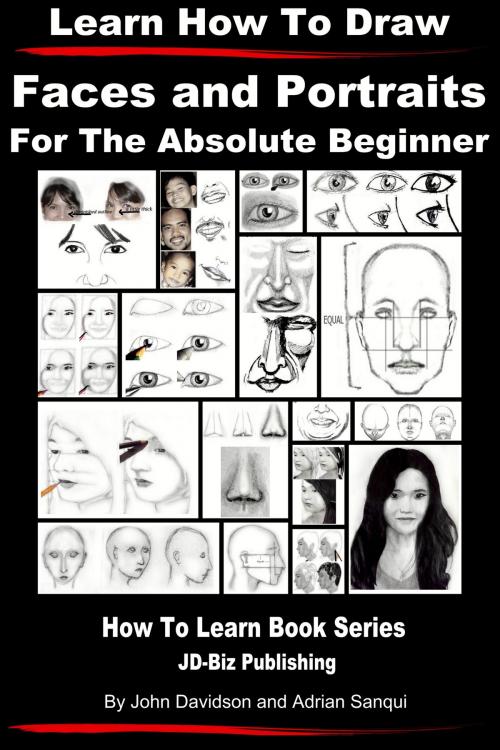Learn How to Draw Faces and Portraits For the Absolute Beginner
Nonfiction, Art & Architecture, Art Technique, Pencil, General Art, Home & Garden, Crafts & Hobbies| Author: | John Davidson, Adrian Sanqui | ISBN: | 9781310228117 |
| Publisher: | JD-Biz Corp Publishing | Publication: | February 16, 2014 |
| Imprint: | Smashwords Edition | Language: | English |
| Author: | John Davidson, Adrian Sanqui |
| ISBN: | 9781310228117 |
| Publisher: | JD-Biz Corp Publishing |
| Publication: | February 16, 2014 |
| Imprint: | Smashwords Edition |
| Language: | English |
Learn to Draw - Faces and Portraits - For the Absolute Beginner
TABLE OF CONTENTS
Introduction: Drawing Tools
Basic Head Layout
Facial Features
Eyes
Nose
Mouth
Measuring Via Eye Size
Front view
Quarter view
Side view/Profile
Basic head layout
There are few characteristics of a head that is relative to almost everyone, this similarity in measurements will be your guide if you are to construct a face when drawing a portrait.
The eyes are positioned below, above or right at the center of the head’s perfect-center level. It is usually aligned with the upper tip of the ear.
The head’s space above and below the eyes’ location are equal.
The nose wings are usually aligned with the tear ducts, and its nose ball is aligned with the ear lobes (this similarity changes depending on the person’s age as the ears grow bigger).
Both tips of the mouth are nearly aligned with the center of both eyes.
Although you will surely encounter a person that has a little difference on these measurements, it would be easier for you to identify his or her unique proportion value if you have the knowledge about what is most usual.
The familiarity to different angles of the head is essential when drawing faces.
Head shapes differ in every angle. The position of each facial feature gradually changes as the head makes a quarter turn. And as it turns further on one side, their sizes slightly change and the features reveal their unseen angles, thus, totally changing their shape.
A head facing in a perfect front view would have two equal sides most of the time, while a head in a quarter angle view shows the outline of the nose bridge which cannot be portrayed perfectly when in front view. The lips would reveal its thickness as it loses the exposure of its further tip. And the further ear and eye will lose its exposure as the head turns further on the side.
These natural gradual adjustments happen when the head moves horizontally.
Unlike horizontal movements, when a head moves in a diagonal direction it changes the diagonal thickness of the head dynamically, thus, the facial features follow.
Each facial feature comes closer together as the head leans further. The nostrils become totally exposed as the nose ball clearly establish its distance from the plane (face surface).
The thickness of the lower lip can be easily conveyed as it overlaps the upper lip, and the eye shapes would appear flat.
When the head moves downwards, the nose (depending on its height) would overlap the lips, and the eyebrows (depending on its thickness) would slightly overlap the eyes. The height of the neck would be hidden as the top of the head becomes clearly conveyed, totally changing or rather hiding the face’s horizontal height.
The facial ridges of males are more defined and prominent compared to females, especially the nose bridge, Brow Bridge and the jaw line.
But there are few cases in which the shape of a man’s profile looks more feminine than usual or vice-versa. In this case, you have to rely on the facial features he or she have to clearly portray his or her gender, such as thick eyebrows or any facial hairs for men or pouty, glossy lips and long eyelashes for women.
Learn to Draw - Faces and Portraits - For the Absolute Beginner
TABLE OF CONTENTS
Introduction: Drawing Tools
Basic Head Layout
Facial Features
Eyes
Nose
Mouth
Measuring Via Eye Size
Front view
Quarter view
Side view/Profile
Basic head layout
There are few characteristics of a head that is relative to almost everyone, this similarity in measurements will be your guide if you are to construct a face when drawing a portrait.
The eyes are positioned below, above or right at the center of the head’s perfect-center level. It is usually aligned with the upper tip of the ear.
The head’s space above and below the eyes’ location are equal.
The nose wings are usually aligned with the tear ducts, and its nose ball is aligned with the ear lobes (this similarity changes depending on the person’s age as the ears grow bigger).
Both tips of the mouth are nearly aligned with the center of both eyes.
Although you will surely encounter a person that has a little difference on these measurements, it would be easier for you to identify his or her unique proportion value if you have the knowledge about what is most usual.
The familiarity to different angles of the head is essential when drawing faces.
Head shapes differ in every angle. The position of each facial feature gradually changes as the head makes a quarter turn. And as it turns further on one side, their sizes slightly change and the features reveal their unseen angles, thus, totally changing their shape.
A head facing in a perfect front view would have two equal sides most of the time, while a head in a quarter angle view shows the outline of the nose bridge which cannot be portrayed perfectly when in front view. The lips would reveal its thickness as it loses the exposure of its further tip. And the further ear and eye will lose its exposure as the head turns further on the side.
These natural gradual adjustments happen when the head moves horizontally.
Unlike horizontal movements, when a head moves in a diagonal direction it changes the diagonal thickness of the head dynamically, thus, the facial features follow.
Each facial feature comes closer together as the head leans further. The nostrils become totally exposed as the nose ball clearly establish its distance from the plane (face surface).
The thickness of the lower lip can be easily conveyed as it overlaps the upper lip, and the eye shapes would appear flat.
When the head moves downwards, the nose (depending on its height) would overlap the lips, and the eyebrows (depending on its thickness) would slightly overlap the eyes. The height of the neck would be hidden as the top of the head becomes clearly conveyed, totally changing or rather hiding the face’s horizontal height.
The facial ridges of males are more defined and prominent compared to females, especially the nose bridge, Brow Bridge and the jaw line.
But there are few cases in which the shape of a man’s profile looks more feminine than usual or vice-versa. In this case, you have to rely on the facial features he or she have to clearly portray his or her gender, such as thick eyebrows or any facial hairs for men or pouty, glossy lips and long eyelashes for women.















